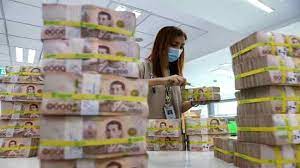BENGALURU/LAHORE (Reuters/Web Desk): Emerging market currencies will take well into next year to start making noticeable gains against a retreating US dollar, despite a growing view the interest rate cycle has peaked, a Reuters poll of FX strategists showed.
After getting battered for most of 2023, emerging market (EM) currencies have made modest gains against the dollar after the Federal Reserve held interest rates steady last week and data suggested the US economy might finally be slowing.
That dollar weakening trend was likely to hold in the near-term as a majority of analysts in the Nov 3-7 Reuters poll expected the dollar to trade lower by year-end.
However, with most EM central banks expected to follow the Fed and cut rates next year, their respective currencies were unlikely to recoup double-digit losses they have accumulated over the past couple of years.
“We’ve seen already some pretty sharp gains last week, but the recent gains aren’t extending because there is still uncertainty about the Fed … and at the same time the US is still performing better than most other economies,” said Mitul Kotecha, Head of FX & EM Macro Strategy Asia at Barclays.
“So it’s difficult to see the EM currencies recoup some of the sharp losses that we’ve seen in the last few months. That said, we do expect some gains, it’s just going to be a bit more of a gradual path.”
This excludes the Russian rouble, which has lost 27 per cent this year, and the Turkish lira, which is down 52pc.
Only a few Asian currencies, such as the Indian rupee, Thai baht, and South Korean won were expected to recoup their losses by late 2024. In the near term, the rupee is forecast to trade in a narrow range.
Although EM currencies gained at the beginning of 2023 and investors brimmed with positivity after China’s post-COVID reopening, economic performance in the world’s second largest economy has been mostly underwhelming.
Indeed, the tightly-controlled Chinese yuan was forecast to only recoup slightly more than half of its 2023 losses. It has fallen over 5pc this year.
The South African rand is set to gain less than 1pc while the Turkish lira is set to fall around 16pc in a year.
Latin America’s stand-out currencies, the Brazilian real and Mexican peso, have gained around 8pc and 11pc respectively since the year began, although some of their central banks have already begun cutting rates.
The peso is expected to lose around 4.5pc while the real is seen losing just over 2pc in 12 months.
“Easier Fed monetary policy should also take some pressure off select emerging market currencies in the second half of next year,” noted Nick Bennenbroek, international economist at Wells Fargo.
PAKISTAN RUPEE
One has to see how Pakistan’s rupee will perform next year as it often moves in directions quite opposite to the global money markets. The latest upward movement of dollar is a proof after the local currency on Tuesday depreciated to Rs286.39.
The series of gains for dollar comes after it halted the rupee surge at Rs276.83 – the official exchange rate recorded on Oct 16 – after it had bounced back from Rs307.10 – the record low in Pakistan’s history after a government crackdown on illegal activities in currency market and cross-border smuggling of greenback.
It means the dollar is up Rs9.56 since then – a blow to those who were expecting the rupee to strengthen and reach the level of Rs250.
The reason behind the money market behaviour in Pakistan is mainly manipulation, with the investors hoarding dollar for a safe haven currency amid the record-high inflation and a weakenign rupee.
Meanwhile, Pakistan hasn’t witnessed any rate cut with the State Bank maintaining that the interest rates at 22 pc – the highest in the country’s history – despite the fact that the market was expecting a cut amid clear signs of inflation already moving down after reaching its peak.







